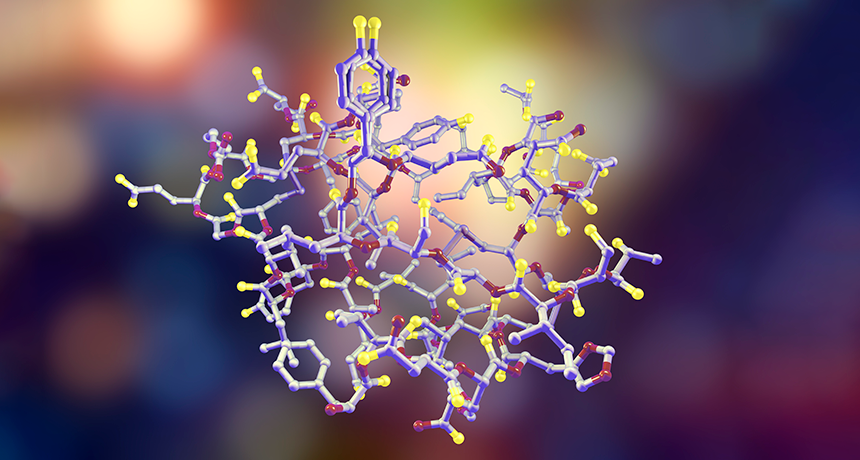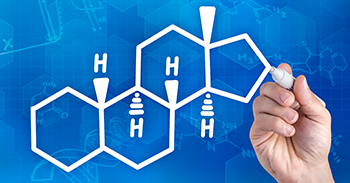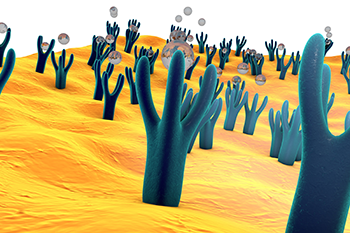Explainer: What is a hormone?
These unsung heroes of the body inform cells when it’s time to go to work

This is an artist’s representation of a molecule of insulin. This hormone helps the body use its food as energy.
Dr_Microbe/iStockphoto
By Janet Raloff
All of us started as a single cell. Along the way, that cell divided and morphed in very individual ways. Some of us may have ended up short or tall, dark skinned or light, clever or slow, night owls or early birds. Scientists like to attribute most of those traits to inherited genes. But much of the work in crafting the traits that make each of us unique is performed by a family of chemicals known as hormones.
Various tissues of the body secrete hormones into fluids, like blood. From there, the hormones travel far from the place they were made until they reach cells that read the chemical as an instruction.
That hormone might tell the cell to grow — or to stop. It might direct a cell to change its shape or activity. These instructions might cause the heart to pump more rapidly or signal hunger to the brain. Another hormone might let you know that you’re full. One hormone latches onto sugar in the bloodstream and then helps ferry that sugar into cells to fuel their work. Yet another might tell your body to burn some nutrients as fuel — or instead store their energy as fat for use at a later date.

What’s more, a hormone can have more than one role. For instance, estrogen is a hormone made by a woman’s ovaries. It helps to shape her body during puberty to look — and function — differently than a man’s. Indeed, during her reproductive years, monthly pulses of estrogen will prepare her breasts for the potential production of milk, something that would be needed if she became pregnant. But estrogen also sends signals to bone to become stronger. Different types of estrogens can even promote or thwart the growth of would-be cancers.
Receiving those messages
Hormones essentially whisper their instructions to affected cells. The “ears” through which cells listen for that instruction are known as receptors. These are special structures on the outside of a cell. If a hormone’s chemical recipe and shape are just right, it will dock into the receptor, like a key into a lock. These receptors are known as “gatekeepers.” If and only if the right hormonal key arrives will that receptor unlock. Now some important, newly specified action will turn on.

Or at least that’s how it’s supposed to work.
Sometimes imposters arrive. Like fake keys, these may inappropriately turn on some cellular action.
Clover, soybeans, fungi and marijuana, for instance, evolved compounds that resemble the estrogen in mammals. Those molecules resemble hormones well enough that consuming some of these can fool the body into thinking it got a legitimate estrogen signal. In fact, it didn’t. This could even happen in males. Since estrogen is hormone that promotes feminine traits, that faulty signal could work to effectively feminize some male traits.
Some estrogen mimics may sit in the lock but fail to turn it on — or perhaps only slightly turn it on. They act like a bad key, stuck in the lock. Now if a true key shows up, it can’t enter the blocked receptor. So it can’t instruct the cell that it’s time to do its job. Some pesticides as well as chemicals used in plastics can do this. If these chemicals mimic testosterone, a male sex hormone, they may block some of the activity that would be turned on when true testosterone showed up. The result could be a male animal that now looks like a female.
Over the past three decades, scientists have been uncovering a growing number of chemicals that the body may mistake for hormones. These include a large number of commercial chemicals, such as pesticides, plasticizers and combustion byproducts. Together, scientists have come to refer to such materials as “environmental hormones.” Other times, they’re called hormone mimics or “endocrine disruptors.” That last term reflects that chemicals are central players in the body’s endocrine — or hormone — system.
Not just for humans
Hormones act throughout the living world.
One reason scientists often use animals as stand-ins for people is because their bodies work similarly. Their bodies often rely on the same hormones to do the same things as in the human body. From mice and pigs to fish, insects, birds and reptiles, creatures throughout the animal kingdom rely on hormones to develop, grow and live out healthy lives.
A number of hormones instruct plants when to grow up — or grow old and die. Others inform a plant that it’s time to form flowers, fruit and seeds so that it can reproduce. Still others trigger the plant to heal some wound or to enter dormancy.
Fungi rely on chemicals to signal when their tissues need to take certain actions, such as communicate with microbes in its root zone or begin spore formation (reproduction). Many such chemicals work as hormones. Sometimes, these chemicals will be identical to hormones produced by plants.
There are even bacteria that make hormones. Those hormones may be help a bacterium sense if has entered a host’s gut and now should attach to the intestinal wall so that it can settle in for a long stay. However, some of the signaling chemicals bacteria make can work primarily in their host (which may even be a human). For instance, some bacteria in the gut can fashion androgens (male reproductive hormones, such as testosterone) from inflammation-fighting chemicals in their environment.
Examples of some human hormones and roles they play
The human body makes around 50 different hormones, which direct the timing of actions by cells and tissues throughout the body. Here are some of them:
| Name | Primary role | Main activities |
|---|---|---|
| Adrenaline | Stress hormone | Known as the fight-or-flight hormone, it helps the body respond to stress by increasing heart and breathing rates and preparing muscles for exertion. |
| Estradiol (also known as estrogen) | Sex hormone | In females, this hormone promotes the growth of feminine traits (such as breasts and padded hips) and prepares the body — from puberty to menopause — to release eggs and nurture a developing fetus through birth. In males, this hormone helps in development of sperm and a healthy sex drive. |
| Ghrelin | Hunger hormone | Produced mostly in the stomach, it alerts the brain that the body is running low on energy and it’s time to eat. |
| Insulin | Metabolic hormone | It helps the body move sugar in the bloodstream into cells where that sugar can be used as fuel. |
| Leptin | Satiety hormone | Secreted mainly by fat cells, it tells the body when it’s had enough to eat. Leptin also signals when incoming food should be burned or stored as fat. |
| Melatonin | Sleep hormone | This hormone is produced by the brain’s pineal gland and readies the body for sleep. |
| Testosterone | Sex hormone | Produced by the testes in males, it tells the male body to develop masculine characteristics, such as facial and body hair, a deep voice and muscle strength. Produced in females by the ovaries and adrenal glands, it promotes such traits as the growth of underarm hair. |
| Thyroxine (also known as thyroid hormone or TH) | Growth hormone | This is the primary hormone secreted by the thyroid. It plays a role in promoting growth of the brain, bone and muscle. It also helps regulate activities of the heart and digestive tract. |







